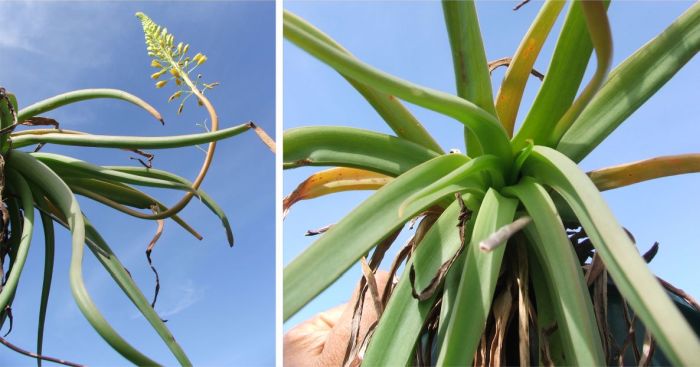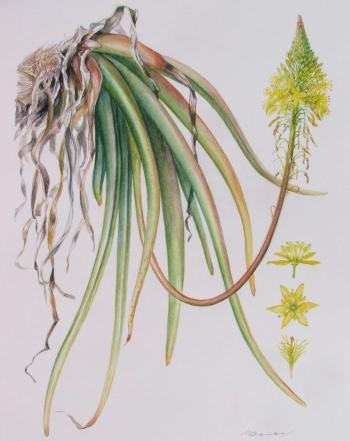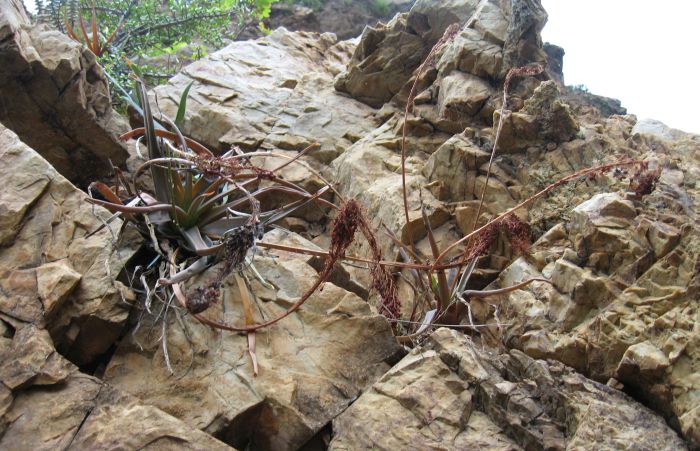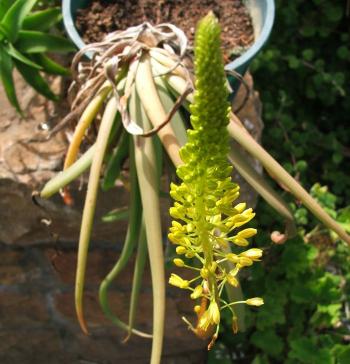Bulbine latifolia var. curvata
Bulbine latifolia var. curvata Van Jaarsv.
Family: Asphodelaceae
Common names: curved-leaf bulbine (Eng.); kromblaarkopieva (Afr.)
Introduction
Bulbine latifolia var. curvata has a solitary rosette of firm, linear-lanceolate, succulent leaves, distinctly curving downwards. It is a cliff-squatting plant with an ascending inflorescence and grows wild along cliffs in the Kouga Dam and Grootrivierspoort region (southwest corner) of the Eastern Cape. It flowers in spring when the solitary inflorescence appears, bearing yellow flowers. Best grown in containers.

Fig. 1. The curved-leaf bulbine (Bulbine latifolia var. curvata) in flower in cultivation at Kirstenbosch National Botanical Garden.
Description
Description
Plants, compared to other species of Bulbine, are slow-growing, with a solitary, often pendent rosette 150 mm in diameter and 250 mm long, from a short branch 70 mm long. The stem is 25 mm in diameter, covered with persistent leaf bases, the latter weathering and forming a fibrous network. Roots are grey, fleshy, terete. The 12–15 leaves in a rosette, with firm texture, pendent or curving downwards, linear-lanceolate, 150–250 × 8–12 mm, flat above, rounded below, light green; margin entire, the tip attenuate, ending in a sharp, short point, the older leaves persistent. The inflorescence grows up to 420 mm long, densely flowered in the distal third. The raceme is conical, 150 mm long, the stalk of the inflorescence (peduncle) up to 7 mm in diameter at base, biconvex, green to reddish green with triangular acuminate bracts, 5 × 1 mm, clasping. The flower stalks (pedicels) 12 mm long. The perianth is star-shaped (stellate), about 15 mm in diameter; the tepals bright yellow with greenish yellow median stripes, outer tepals narrowly oblanceolate, 10 × 2 mm, inner tepals elliptic to elliptic-oblanceolate, 9 × 3 mm; apices obtuse to emarginate. The stamens are 7 mm long, bearded in central part, 2.5–3.0 mm. The ovary is rounded (globose), 1.5 mm in diameter; style erect, up to 7 mm long. Fruit obovate, 3.0 × 2.5 mm. Seeds 3.0 × 1.5 mm, black.
Flowering is mainly from late spring to early summer (October–November). Seeds dispersed by wind in summer and early autumn.

Fig. 2. Bulbine latifolia var. curvata, an illustration by Vicki Thomas of the type plant grown at Kirstenbosch National Botanical Garden, from Keurkloof near the Kouga River.
Conservation Status
Status
Although rare and restricted to cliffs in the Kouga and Grootrivier tributaries of the Gamtoos River it is well protected by its habitat. Consequently it is not threatened and is assessed as Least Concern (LC) in the Red List South African plants. The plants are safeguarded by their difficult to reach habitat, as well as its distribution falling within a greater conservation region.

Fig. 3. Curved-leaf bulbine (Bulbine latifolia var. curvata) in habitat on the sheer cliffs at Kouga Dam.
Distribution and habitat
Distribution description
Bulbine latifolia var. curvata is only known from vertical cliffs, at an altitude of about 250–500 m altitude, above the Kouga River and Grootrivierspoort (mainly eastern and western aspects) and adjacent territory. Plants are firmly rooted in crevices, the plant size often depending on the growing space allowed by the crevice. Temperature is high in summer (35–40ºC). Winters are cooler, but frost is a rarity or absent. The average daily maximum temperature is about 25ºC and the average daily minimum about 10ºC. Rainfall occurs throughout the year but with a peak in spring and summer, ranging from 400–500 mm per annum (thunder showers or cyclonic winter rain).
The geology consists of quarzitic sandstone (light-coloured and smooth-textured), Peninsula Formation (Cape Supergroup) giving rise to a mineral-poor acidic soil.
The plant grows in full sun or partial shade, also depending on the aspect.
The associated vegetation consist of Gamtoos Thicket (Mucina et al. 2005) and the plant shares its cliff-face habitat at the Kouga Dam and Grootrivierspoort with species such as Albuca cremnophila, Aloe mitriformis and A. pictifolia, Cotyledon tomentosa, Crassula perfoliata var. minor, C. perforata, C. rupestris subsp. rupestris, C. rupestris subsp. kouga and C. socialis, Cyrtanthus flammosus and C. montanus, Gasteria glomerata, Haworthia viscosa and H. translucens.

Fig. 4. Two plants of the curved-leaf bulbine (Bulbine latifolia var. curvata) in habitat at the Kouga Dam, taken from below.
Derivation of name and historical aspects
History
Bulbine latifolia var. curvata was named by the author in the magazine Aloe which specializes in succulent plants, in 2003, from plants collected on sheer cliffs along the Kouga Dam.
Bulbine latifolia var. curvata is at once distinguished by its slow-growing, solitary rosettes, with linear, attenuate, firm leaves becoming reddish during the dry season and which curve downwards. It reminds one of B. cremnophila, but the plant is much larger. The leaves of B. cremnophila also curve downwards but are glaucous and very soft and fragile. It belongs to a group of summer-rainfall, broad-leaved Bulbine species. Bulbine latifolia var. latifolia has broad leaves and plants are usually fast growing.
The stem of Bulbine latifolia var. curvata is short, the persistent leaf bases weathering to a fibrous, mat-like network. The leaves retain their drooping nature in cultivation.
Ecology
Ecology
Obligatory cliff-dwelling plants are dependent on the cliff for a place of growth, to exchange their genes and disperse their offspring. They are plants which are exiled to a life on cliffs. If the cliff disappears, the plant disappears as well, a cul de sac. They have become cliff specialists and the rock their salvation. The vertical rock face is the only constant in this environment. This habitat has its advantages and disadvantages. The disadvantage is the vertical habitat, with limited foothold and the ever presence of gravity to deal with. The moisture content of the crevices and ledges is also limited and procreating a challenge. In spite of the difficult environment there are also many advantages, such as a relatively safe environment, with no larger herbivores to deal with. The result is many cliff-dwelling succulents tend to lessen or lose their armament (spiny nature or bitter sap). Most plants here are growth and reproductive specialists. Dewinteria petrophila for instance, has evolved a dual floral and seed dispersal strategy. Because of the limited moisture supply succulence is a great advantage, and small wonder that succulents often dominate life on cliffs in many parts of South Africa and especially the Gamtoos River System in the Eastern Cape, where the greatest diversity of cliff-dwelling succulents in South Africa was recorded. The cliff habitat here was created by the river system cutting through hard, 500 million years old quarzitic sandstone mountains, which allowed access for many obligatory succulent cliff-face specialists, such as Bulbine latifolia var. curvata, which grows in this river system and have been recorded from the Grootrivier system.
Another factor here is the quarzitic sandstone, mineral-poor soil, which further limits their resources. Bulbine latifolia var. curvata is such a cliff specialist. The plants, unlike most other species of Bulbine which grow rapidly, are slow growing, using limited resources and become pendent as well, as the leaves curve towards the source of gravity. Its sluggish growth could perhaps be due to the mineral-deprived cliff habitat.
Solitary species of Bulbine such as B. latifolia var. curvata flower annually, ensuring maximum seed output.
The flowers of Bulbine latifolia var. curvata are cross-pollinated by insects, the seeds dispersed by wind in late summer or autumn, the best time for receiving rain in its habitat. The ascending inflorescence curves upwards and away from the cliff to maximise visibility. The turbulent updrafts, often found in a hot cliff environment, scatter the seeds and if one falls in a suitable ledge or crevice and with sufficient moisture, the seed will germinate.
Uses
Use
No medicinal or cultural uses have been recorded.

Fig. 5. The curved-leaf bulbine (Bulbine latifolia var. curvata) in flower in a container at Kirstenbosch National Botanical Garden.
Growing Bulbine latifolia var. curvata
Grow
Bulbine latifolia var. curvata is easily grown from seed. It is best grown as a pot plant in partial shade and kept in small containers, simulating the small crevices of the cliff environment.
In its habitat at the Kouga Grootrivierspoort, rain can be expected any time of the year but more so from spring to autumn. Therefore, best to water well in summer and keep dry in winter. The plant is also frost-prone and should be protected during winter.
The soil should be sandy, and well-drained. Best to make use of an organic fertiliser, such as compost (well broken down). As a pot plant, it is best on a balcony or windowsill.
Sow seed in spring, summer or autumn in a sandy medium. First moisten the substrate with a fine rose. Cover the seed lightly with a thin layer of sand. Keep moist and in a shady position. Germination is usually within 3 weeks and the young seedlings slow-growing. Transplant seedlings to individual containers once large enough to handle.
Plants are relatively disease free but a leaf ring fungus, slugs and snails can sometimes be a problem.
References
- Manyama, P.A. & Kamundi, D.A. 2006. Bulbine latifolia (L.f.) Schult. & J.H.Schult. var. curvata Van Jaarsv. National Assessment: Red List of South African Plants version 2020.1. Accessed on 2021/05/11
- Mucina, L. & Rutherford, M.C. (eds) 2006. The vegetation of South Africa, Lesotho and Swaziland. Strelitzia 19. South African National Biodiversity Institute, Pretoria.
- Van Jaarsveld, E.J. & Forster, P.I. 2001. Bulbine. In U. Eggli, Sukkulenten Lexicon (Band 1). Einkeimblattrige Pflanzen (Monocotyledonen). Ulmer, Stuttgart.
- Van Jaarsveld, E.J. & Van Wyk, A.E. 2003. Four new cliff-dwelling Bulbine taxa (Asphodelaceae) from the Eastern and Western Cape. Aloe 40(1): 4–7.
Credits
Ernst van Jaarsveld
Kirstenbosch National Botanical Garden (Retired 2015)
Babylonstoren Farm
Extraordinary senior lecturer and researcher,
Department of Biodiversity and Conservation, University of the Western Cape
May 2021
Plant Attributes:
Plant Type: Succulent
SA Distribution: Eastern Cape
Soil type: Sandy
Flowering season: Spring, Early Summer
PH: Acid
Flower colour: Yellow
Aspect: Morning Sun (Semi Shade), Afternoon Sun (Semi Shade)
Gardening skill:
Special Features:
Horticultural zones








Rate this article
Article well written and informative
Rate this plant
Is this an interesting plant?
Login to add your Comment
Back to topNot registered yet? Click here to register.